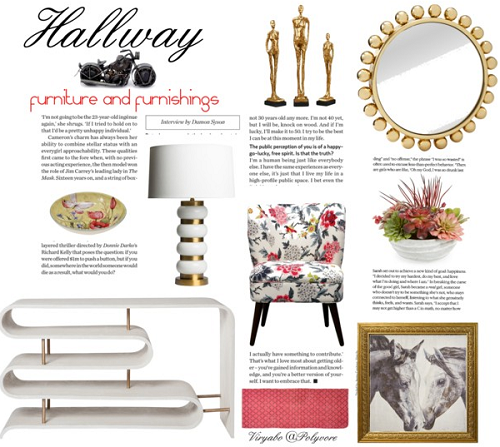As bedroom spaces become smaller, we need to be more creative with storage solutions.
Coming up with storage ideas by using spaces and furniture optimally requires some thought and the best way to approach the issue is to draw up a rough floor plan of the entire bedroom space, including the areas designated for furniture.
 |
| Bedroom Storage Ideas (created by Viryabo@Polyvore) |
Plan for both vertical and horizontal spaces for bedroom storage, especially if your apartment doesn’t come with a walk-in closet; this way, it’s easy to start thinking and sketching out the kind of units that will work best for your room.
Types of Bedroom Storage
There are two types you can use in a bedroom.
- Standalone storage furniture
- Built-in units
Standalone furniture for storage includes the chest of drawers, armoires, bedside cabinets, storage beds, dresser, wardrobes, tallboy, and highboy while built-in units include fitted wardrobes, built-in chests, and floor to ceiling wardrobes.
Features of bedroom storage include:
- Long and short hanging sections (long hanging sections are good for hanging full-length gowns and dresses, trousers, long skirts, overcoats, etc... while the short hanging spaces are ideal for hanging skirts, blouses, shorts, shirts and the like) with inner lighting
- Open or closed shelves for folded clothing, tees, hat boxes, etc...
- Drawers for undergarments, socks, scarves, odds and end stuff, etc...
- Pull out wire baskets for sundry items, or anything you may wish to store away in an easy to access an airy unit.
- Shoe racks, bag racks, and belt hooks
- Upper storage spaces for large boxes, suitcases (if you don't have ample closet storage), etc...
- Jewellery lock-away sections, travel and other important documents
If you are designing your bedroom DIY wise, consider space for the above when mapping out your sketch. If you are hiring an interior designer to do the job, start off by discussing all your storage requirements him or her.
You can also find bedroom fitters at your local home improvement stores. A designer or fitter should present you with a simple to read and understand plan with working drawings that show how spaces will be divided and allocated.
Integrate Storage Design Ideas with Bedroom Style
Bedroom or closet storage and organisers must be well integrated with the total design concept of the bedroom and its décor. For instance, a heavy rich mahogany wardrobe may be beautiful and elegant, but it will look out of place if incorporated within a room that has an ultramodern dresser and country style nightstands.
Likewise, you wouldn’t want to mess-up your minimalist less-is-more look with a heavy oak bed, an elaborate foot chest, and some heavy ornately carved headboard.
However, it’s good to note that if you are one that has a preference of say an eclectic theme or absolutely love Bohemian décor, then set interior design rules don’t necessarily apply.
Any which way, it’s best to choose a bedroom design that's not only pleasant but also possesses great potentials for a good variety of storage solutions.
Affordable Storage Solutions
If you are on a tight budget and want to organise things inexpensively, go for built-in wardrobe units without the doors. Instead, install roll-up blinds (wood, bamboo, or fabric) or drapes which coordinate well with the room's colour scheme.
This idea is great for hiding everything in a visually pleasing manner and can be applied for dead corners, niches or a wardrobe recess.
Louvred doors that can be found at most local D.I.Y. stores are another alternative. They are lovely, have character, and are very affordable to serve as doors.
Finally, if you live in a tiny flat where your bedroom serves a dual purpose . . . as a living room during the day and as a bedroom at night, what appears to be a wall in the daytime can be pulled out at night to form a bed with a sprung mattress and built-in lighting. This storage idea works great where space is limited like is common in studio apartments or converted lofts.
Articles
10 ways to Add Charm to Your Bedroom
Bachelor's Bedroom Design Ideas
Fish Tank Coffee Table
Home Decor Fabrics By the Yard






